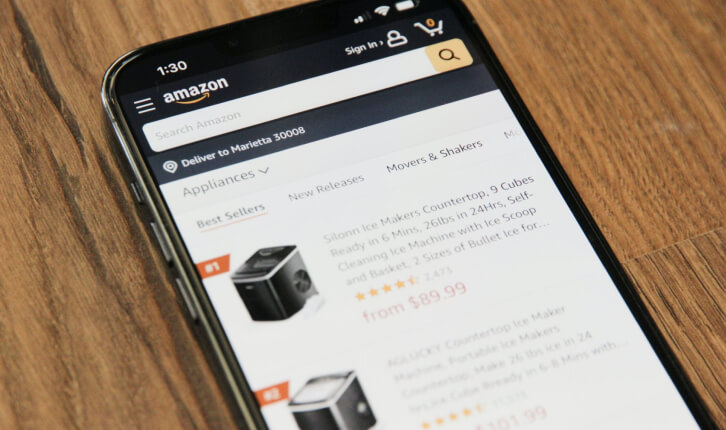Published on: January 26, 2023 | Last updated on: July 22, 2024 | Estimated reading time: 3 minutes
Imagine a shopper has had their eye on one of your products for a really long time. They’ve done all their research, ticked everything off their own internal checklist – they’re ready to go.
Now imagine, for some reason or another, they won’t convert. Can’t bring themselves to do it.
Eventually, they abandon their cart altogether, leaving you (once again!) without a sale.
Checkout abandonment is a common occurrence on the digital shelf, mainly because of the choice customers have nowadays. How are you going to create a sense of certainty with a purchase when they’ve got all this competition staring them in the face?
In this article, we explore what causes checkout abandonment and how you can prevent it from harming your business’s bottom line.

Essentially, checkout abandonment is the percentage of visitors to your website that add items to their cart but don’t purchase them.
Got a travel company that customers just aren’t booking through? Maybe you own a financial institution seeing a drop in sign-ups? Whatever your business, checkout abandonment is definitely not the way to win at the digital shelf.
But checkout abandonment itself doesn’t make any sense! After all, customers wouldn’t have gotten as far as the checkout if they weren’t interested in your products/services.
Something must have stopped them along the way, and for the sake of your brand, you must find out what!
Checkout abandonment can be quantified if you use the following formula:
Checkout abandonment = total number of complete transactions / total number of transactions initiated
You can measure checkout abandonment across any timeframe. For instance, your monthly checkout abandonment rate would be the total number of complete transactions divided by the total number of transactions initiated over any 30-day period.
Weekly checkout abandonment is measurable in the same way – either over a five- or seven-day period, depending on your requirements.
Reduce your checkout abandonment rate with these proven tips from the Magpie DBX team:
Don’t confuse your customers; they will only shop elsewhere. Instead, simplify your sales process in the lead-up to checkout so that abandonment is the last thing on their minds.
First, remove any unnecessary steps; be ruthless in your approach. Then, streamline your essential elements so that they are more accessible to everyday shoppers. We promise they’ll thank you for it!
Have you ever found yourself frustrated at creating an account somewhere just because you’re prompted to?! Yes, we get it.
Many shoppers have this exact same gripe, so remove it from your sales funnel altogether. Give customers the option to ‘Check Out As Guest’ or similar, and encourage them to sign up if they’re interested afterwards. You should see checkout abandonment decrease significantly.
‘Buy Now’, ‘Make a Booking’, ‘Sign Up’ – all successful ecommerce businesses use calls to action (CTAs) to drive shoppers towards a conversion.
Make sure these are clearly signposted around your website, in the most opportune places. If customers understand what you want from them, they’ll be more likely to give you the time of day rather than simply shopping elsewhere.
Sales promotions at checkout are a great way to keep customers engaged and coming back for more. Devise a strong promotional strategy that capitalises on customers’ love for first-rate deals and offers.
And don’t forget, with Magpie DBX you can use our promotion tracker to see which promotions are performing best – then adjust accordingly.
We live in a very busy world, and people like to have options when it comes to how their items are delivered.
Use the Magpie Stock and Delivery feature to base your delivery options around not just customer demand but also your own capabilities. You don’t want to leave shoppers angry or disappointed in your brand!
Customers like to engage with their favourite brands, so being supportive by making yourself accessible is a great way to encourage them to stick with you.
Build a chat bot, maintain an active presence on social media, and respond to feedback promptly so that you can be the company they rely on.
At Magpie, we want to help you make the most of your digital shelf journey. Our tools will help you identify key problem areas for checkout abandonment, so you can deal with them effectively.
Leave it to us and we’ll tailor the entire Magpie suite to suit your business needs, whether they’re focused on price tracking, brand compliance or other key KPIs.
Want Magpie DBX to help reduce your checkout abandonment rate? Contact us today to request a demo!
Ready to receive more market insights from Magpie? Be sure to follow us on social media.

As a thriving business, launching products is always an exciting time.
You’ve got the initial anticipation, then the launch date itself, and finally (hopefully) the inflated sales figures that follow.
But some companies experience negative consequences on the digital shelf after releasing the brand-new product they’ve worked so hard to perfect; instead of attracting customers from other brands, they end up stealing sales from themselves. This can be explained through one increasingly common phenomenon: product cannibalisation.
In this article, we look at product cannibalisation in detail, covering what it is, the potential causes and impact, as well as tips on how to avoid making the same mistakes as other businesses.

Pricing your products competitively while securing a healthy profit margin is the ambition of every business. With customers now more tech-savvy and commercially aware than ever, competitor price monitoring is essential.
But how exactly do you stay ahead of your competition and keep prices consistent?
In this article, we’ll show you 10 ways to beat competitors without changing your prices, and explain what Magpie DBX can do to help your company maintain its pricing position.

Appearing on the digital shelf involves more than just listing your products across multiple channels.
It’s about making sure that you’re presenting them in the right way, so that customers will keep using your brand because they trust that you can deliver.
But retaining customers means first maximising your digital shelf visibility, which is tricky given how crowded the online space has become.
In this article, we look at why digital shelf visibility is so important, as well as suggesting ways of appearing more visible across the internet.
Want to learn more about how Magpie DBX can help your business? Get in touch with us and let us show you!



